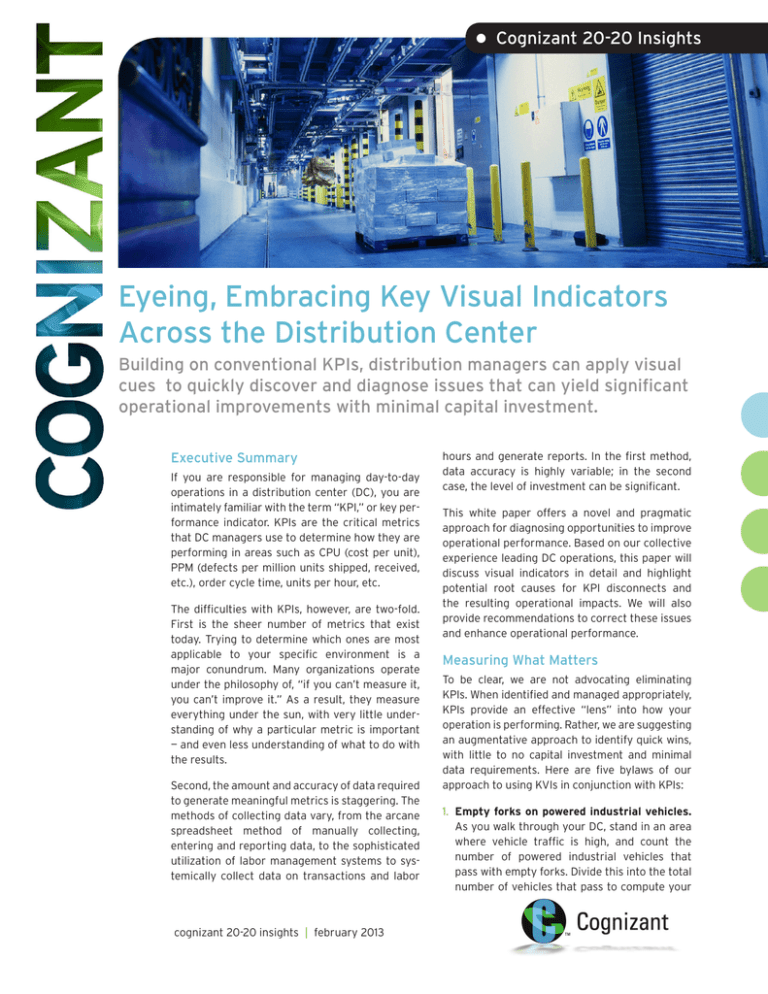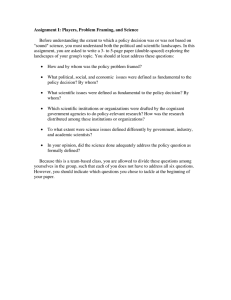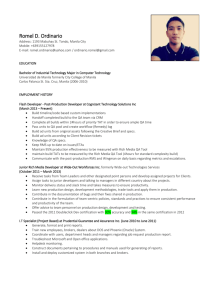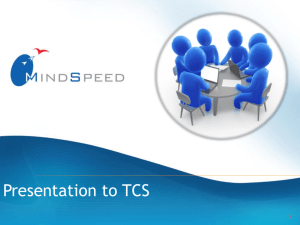
• Cognizant 20-20 Insights
Eyeing, Embracing Key Visual Indicators
Across the Distribution Center
Building on conventional KPIs, distribution managers can apply visual
cues to quickly discover and diagnose issues that can yield significant
operational improvements with minimal capital investment.
Executive Summary
If you are responsible for managing day-to-day
operations in a distribution center (DC), you are
intimately familiar with the term “KPI,” or key performance indicator. KPIs are the critical metrics
that DC managers use to determine how they are
performing in areas such as CPU (cost per unit),
PPM (defects per million units shipped, received,
etc.), order cycle time, units per hour, etc.
The difficulties with KPIs, however, are two-fold.
First is the sheer number of metrics that exist
today. Trying to determine which ones are most
applicable to your specific environment is a
major conundrum. Many organizations operate
under the philosophy of, “if you can’t measure it,
you can’t improve it.” As a result, they measure
everything under the sun, with very little understanding of why a particular metric is important
— and even less understanding of what to do with
the results.
Second, the amount and accuracy of data required
to generate meaningful metrics is staggering. The
methods of collecting data vary, from the arcane
spreadsheet method of manually collecting,
entering and reporting data, to the sophisticated
utilization of labor management systems to systemically collect data on transactions and labor
cognizant 20-20 insights | february 2013
hours and generate reports. In the first method,
data accuracy is highly variable; in the second
case, the level of investment can be significant.
This white paper offers a novel and pragmatic
approach for diagnosing opportunities to improve
operational performance. Based on our collective
experience leading DC operations, this paper will
discuss visual indicators in detail and highlight
potential root causes for KPI disconnects and
the resulting operational impacts. We will also
provide recommendations to correct these issues
and enhance operational performance.
Measuring What Matters
To be clear, we are not advocating eliminating
KPIs. When identified and managed appropriately,
KPIs provide an effective “lens” into how your
operation is performing. Rather, we are suggesting
an augmentative approach to identify quick wins,
with little to no capital investment and minimal
data requirements. Here are five bylaws of our
approach to using KVIs in conjunction with KPIs:
1. Empty forks on powered industrial vehicles.
As you walk through your DC, stand in an area
where vehicle traffic is high, and count the
number of powered industrial vehicles that
pass with empty forks. Divide this into the total
number of vehicles that pass to compute your
utilization percentage. Anything less than 80%
points to an opportunity for improvement.
Typical root causes include overstaffing forklift
drivers and not designing the building layout/
flow to take advantage of roundtripping.
perform these administrative functions will
pale in comparison to the increased productivity and morale of having your leaders visible,
accessible and focused on identifying and
removing performance barriers.
One example is supplies. Typically, supplies are
managed with a dedicated forklift driver that
is considered to be a “utility” function (that’s
fancy wording for indirect labor). A different
approach is to locate your supplies in an area
that fits into the natural vehicle flow, so your
driver can put away product in a racking/
module, then retrieve supplies (pallets, slip
sheets, etc.) en route to the
dock. If you look
The cost of getting inbound
hard enough, these types of
someone to perform opportunities are abundant
these administrative in your DC. Addressing this
multiple impacts. Lift
functions will pale in has
truck drivers are typically
comparison to the the highest paid employees
increased productivity and the hardest to find/
so increasing
and morale of having train/retain,
driver utilization has a
your leaders visible, direct impact on cost-peraccessible and focused unit. Lift trucks are also
to procure and
on identifying and expensive
maintain, so it is critical that
removing performance your organization optimizes
barriers. its fleet to minimize capital
expenditures and maintenance costs.
3.Instill a housekeeping conscience and
culture. If you walk through your DC and see
pieces of wood, paper backing or just trash in
general, you don’t just have a housekeeping
problem; these conditions are usually symptomatic of a much larger problem regarding
organization, commitment and the overall
discipline of your management team. In the
best organizations, ownership is a key theme.
The mantra: Treat the facility like it’s your own.
Ownership is reflected in the way the facility is
maintained, orders are managed and individual
workstations are maintained.
We have seen ownership become contagious
across the DC when leaders embrace it. In
one example, we have seen everyone from an
employee on the receiving dock to the general
manager of the building stop and pick up trash
rather than walking by and ignoring it. That
type of simple gesture permeates the building
and manifests itself in higher quality, productivity and attendance, as well as reduced
turnover. In sum, people will work harder and
stay longer if they are proud of — and happy
with — their work environment. Conversely, in
organizations where housekeeping is lax, it
is usually accompanied by poor organization
in other areas of the DC, lower commitment
levels from all employees in the building and
a negative impact on operational performance
(quality, productivity, etc.).
2.Reconfigure where frontline supervisors sit.
If your supervisors sit in an office, move them
to the floor immediately. The typical pushback
is that they need privacy for personal meetings
with employees, or they need a space to do
paperwork. This contention is simply untrue.
To address the first concern, convert offices
into conference rooms that are available
for private meetings. To address the second
concern (and listen carefully), if your supervisors are doing paperwork or admin functions,
stop! Hire someone to do time and attendance,
enter production data, etc. — your first-line
supervisors are your first-line leaders. They
are the ones with whom your associates most
closely identify, and their primary responsibility should be to engage co-workers and
focus on eliminating barriers and obstacles
that prevent effective job performance — not
pushing pencils or punching keys on a keyboard
but leading. The cost of getting someone to
cognizant 20-20 insights
Implementing
housekeeping
scorecards,
conducting walkthroughs side-by-side with
informal associate leaders in your building
and making housekeeping an integral and
consistent part of your building communication plan are quick, low-cost actions you can
take now.
4.Reduce frequent and excessive distance
travel. A long time ago, we learned there are
two critical elements for running an efficient
DC operation — travel and touches. There are
multiple causes of frequent travel, but fortunately there are also many solutions.
Go to an area of your DC, and observe your
associates performing their job functions. Have
a layout of that area in your hand when you do.
2
A Radical Warehouse Makeover
Before
Sloppily organized pallets
that are difficult to access.
Supervisors stay in
background, out of
sight, out of mind.
Suboptimal
picking and
packing.
Long distance between
key activities, requiring
frequent back-andforth trips.
After
Clean and better
organized pallets that
are easier to access.
Subordinate
assists supervisor
with paperwork.
Supervisors
stand where
the action is.
Shorter distance between
key activities, resulting
in more efficient time
management.
Figure 1
Every time an associate walks to get product or
supplies or move freight to a problem area, etc.,
draw a line on your layout connecting where
they traveled from and to. Do this every time,
and you’ll have a lot of lines on your sheet.
This is what’s known as a spaghetti diagram.
Pay particular attention to where the lines
are dense, as this indicates a disproportionate
amount of travel. This is your starting point for
reducing travel.
Examples include an associate traveling to a
supermarket to get boxes for his pack station or
walking to a problem area to drop off exception
orders (wrong quantity, wrong item, etc.). In
the first example, one option could be to place
corrugate in the pack area based on usage,
thereby decreasing the distance the associate
has to walk, improving productivity and order
cycle time throughout the DC. In the second
example, a solution could be installing lights at
workstations that an associate could flip on if
she has an exception order and a designated
associate can respond, collect the order and
transport it to an exception processing area,
thereby allowing the employee to maintain
consistent throughput, improving order cycle
time and overall DC flow.
cognizant 20-20 insights
Whenever possible, try to have an associate
accompany you during this assessment. The
intent is to train and develop as many “critical
eyes” as possible; rather
than engaging in a one-time Merchandise flow is
exercise, opportunities for to the DC as blood
travel reduction become
a self-sustaining practice flow is to the body.
that everyone on the team Too much or not
can identify and share. enough, and your
Knowledge and empowerment are indeed powerful operation starts to
“multipliers” in driving oper- clot or starve.
ational improvement.
5.Reduce piles of merchandise/cartons, buildup of pallets, operational areas with no
work, etc. All of these are symptoms of poorly
managed work flow. Merchandise flow is to the
DC as blood flow is to the body. Too much or
not enough, and your operation starts to clot
or starve. Impacts of this condition include
materials congestion, reduced productivity, safety hazards, double-handling, increased
order cycle times, missed shipping deadlines,
etc. Sadly, too many operators create a plan
under the “set it and forget it” mentality. They
establish the plan, and only react when an
area becomes excessively congested or runs
3
out of work. Flow is something that must be
managed/monitored in real-time, continuously. Fortunately, many things can be done
to identify issues quickly, enabling appropriate
and timely reaction and mitigating the impacts
mentioned above.
A simple fix is to examine units picked/packed/
sorted and make sure there is balance across
interdependent areas. If you pick 3,000 units,
but only pack/sort/ship 1,500 units, you have
the beginnings of a bottleneck. We recommend
monitoring every 15 to 30 minutes in a manual
system, or building warehouse management
system capabilities where alerts are sent when
a specific condition exists (i.e., picked units
exceed packed by X%, or vice versa). This will
enable quick reaction vs. waiting and having
to enact “massive moves” from one area to
another.
Another simple suggestion is to utilize visual
controls to signal when an area is nearing a
critical high or low point. An example could be
to train a photo-eye on a pack line that lights
up and sounds an alarm when it is unblocked
for more than a set period of time, indicating
your packing work queue is running low. A
second example could be to install an audible
alarm when your put-away queue reaches a
certain number of pallets/carts, etc., indicating
a need to shift labor from receiving to put-away
to avoid dock congestion.
Running Better, Running Different
This paper has identified five focus areas for your
DC to begin embracing KVIs in conjunction with
KPIs to drive world-class performance. These are
simple, low-cost and immediate impact areas that
will yield tangible benefits in productivity, cost,
cycle time and employee engagement.
If you are considering delaying or waiting until the
time is right to take action, just remember your
competitors probably are not. By acting now, you
can achieve better margins, higher accuracy rates
and better customer service levels, which will
help your organization compete in a world where
customers continue to demand product faster,
cheaper, more accurately and on time, every time.
About the Author
John Lowe is a Senior Manager within Cognizant Business Consulting’s Retail Practice. He is responsible
for advising on logistics and supply chain management projects across multiple Fortune 100 clients.
He previously led DC operations for multiple Fortune 500 organizations, including Amazon.com, TJX,
Gap, Inc. and Rockwell Automation. John received his M.B.A. from the University of Illinois at UrbanaChampaign. He can be reached at John.Lowe@cognizant.com.
About Cognizant
Cognizant (NASDAQ: CTSH) is a leading provider of information technology, consulting, and business process outsourcing services, dedicated to helping the world’s leading companies build stronger businesses. Headquartered in
Teaneck, New Jersey (U.S.), Cognizant combines a passion for client satisfaction, technology innovation, deep industry
and business process expertise, and a global, collaborative workforce that embodies the future of work. With over 50
delivery centers worldwide and approximately 156,700 employees as of December 31, 2012, Cognizant is a member of
the NASDAQ-100, the S&P 500, the Forbes Global 2000, and the Fortune 500 and is ranked among the top performing
and fastest growing companies in the world. Visit us online at www.cognizant.com or follow us on Twitter: Cognizant.
World Headquarters
European Headquarters
India Operations Headquarters
500 Frank W. Burr Blvd.
Teaneck, NJ 07666 USA
Phone: +1 201 801 0233
Fax: +1 201 801 0243
Toll Free: +1 888 937 3277
Email: inquiry@cognizant.com
1 Kingdom Street
Paddington Central
London W2 6BD
Phone: +44 (0) 20 7297 7600
Fax: +44 (0) 20 7121 0102
Email: infouk@cognizant.com
#5/535, Old Mahabalipuram Road
Okkiyam Pettai, Thoraipakkam
Chennai, 600 096 India
Phone: +91 (0) 44 4209 6000
Fax: +91 (0) 44 4209 6060
Email: inquiryindia@cognizant.com
­­© Copyright 2013, Cognizant. All rights reserved. No part of this document may be reproduced, stored in a retrieval system, transmitted in any form or by any
means, electronic, mechanical, photocopying, recording, or otherwise, without the express written permission from Cognizant. The information contained herein is
subject to change without notice. All other trademarks mentioned herein are the property of their respective owners.






